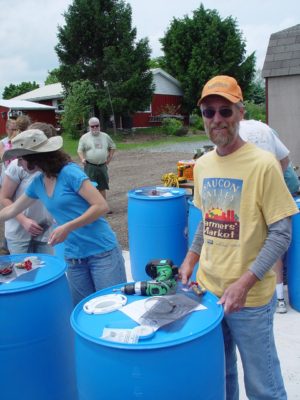
Last Saturday I went to a rain barrel workshop at Edge of the Woods Nursery put on by the Saucon Creek Watershed Committee. For $35, they provided the tools, the materials and help to build a 55 gallon rain barrel. Rain barrels help slow down the flow of water off of roofs. Suburban sprawl with its McMansions, additional roads, big box stores, big parking lots and lawns have caused many areas to become flood prone that never had this problem before. Rain showers now cause flooding, erosion and water pollution. 70% of water pollution in our lakes and streams comes from rainwater run-off. 80% of water falling on grass lawns runs off. Anything we can do to slow the flow and allow more of this water to filter through plants and soil will help to prevent flooding and pollution.
The simplest step that we can take to slow down the flow of water is to place rain barrels on our downspouts. This reduces the amount of rain flowing across the ground by catching the first 55 gallons in a rain event, saving it to be used on dry days. This reduces the amount of nonpoint source pollution. Rain barrels provide some additional benefits as well. 30% of our water is used for lawns and gardens, on average. If you use captured rainwater to water your garden and lawn you reduce your water and sewer bills and save drinking water resources. Rainwater is better for your plants than city water that has been chlorinated.

Now you can buy fancy, good-looking rain barrels from various gardening catalogs and some big box stores; or you can make them fairly inexpensively from a salvaged, food additive barrel and a few parts from the hardware store. The thread taps are pretty expensive, so try to borrow these from a plumber or join a gardening club or watershed association that can buy them corporately to sponsor events like the one I attended on Saturday.
Here’s the recipe:
Ingredients:
1 food grade plastic 55 gallon drum. (SCWC gets theirs from a local recycling center.)
1 PVC toilet drain flange
2 self-tapping 3/4″ hex-top, slot screws
1 dryer vent duct ring
about a square foot of nylon window screen
1 brass 1/2″ hose spigot
1 nylon 3/4″ thread, garden hose coupler
epoxy putty
Tools:
Electric drill
handheld jigsaw
Adjustable wrench
4-5/8″ hole saw
3/4″ garden hose thread tap
13/16″ hole saw
7/16″ drill bit
thread tap for 1/2″ hose spigot
scissors
screwdriver or hex driver bit
Directions:

Use 4-5/8″ hole saw to cut a hole in the top of the barrel, leaving enough flat surface around it to place the toilet flange. Attach screen to bottom of flange using the dryer duct ring. (See photo above.) Trace and cut space on the side of the hole for the tightening screw to fit, so the flange lies flat, screen side down in the barrel.
Drill hole for spigot near the bottom of the side of the barrel using the drill bit. Consider carefully how you want to place this according to how the downspout will enter it, so you will have convenient access to use the water. Tap the threads and screw in spigot. Near the top of the barrel but still on the flat part of the side of the drum, cut the hole with the smaller hole saw for the overflow fitting. Use the larger tap to thread the opening, then screw in the hose coupler. Work the two parts of the epoxy putty together until it is a uniform color. Partially unscrew the spigot and the hose coupler. Work the putty into the threads and retighten, packing it all around to prevent leaks.
Your rain barrel is complete!

Don’t drink the water from your barrel. If you have asbestos shingles (very old roof) or treated wood roof or a copper roof with a zinc anti-moss strip, do not use the water on edible plants. It is fine for flowers and lawns, though. Clean the bug screen periodically. In the winter, either take it in or leave the spigot open with no hose attached to avoid freezing and thawing from splitting your barrel.



